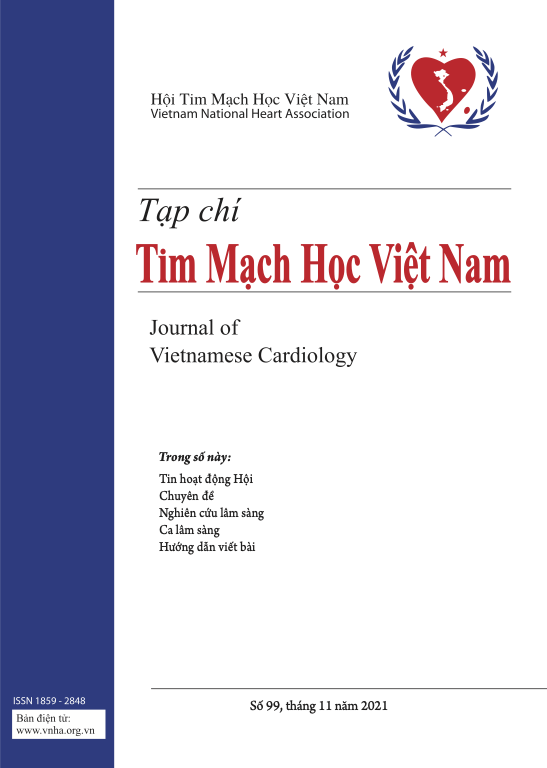Đánh giá một số thang điểm trong dự báo khả năng tái phát ở bệnh nhân rung nhĩ bền bỉ được triệt đốt bằng năng lượng sóng có tần số radio
DOI:
https://doi.org/10.58354/jvc.110.2024.690Từ khóa:
rung nhĩ bền bỉ, triệt đốt rung nhĩ bền bỉ, CAAP-AF, APPLE, MB-LATER, FLAME, ATLASTóm tắt
Đặt vấn đề: Rung nhĩ là một rối loạn nhịp khá thường gặp trong lâm sàng. Điều trị rung nhĩ gồm 3 phần quan trọng: điều trị chống đông dự phòng đột quỵ, kiểm soát tần số và chuyển nhịp. Điều trị rung nhĩ bền bỉ bằng sóng có năng lượng tần số radio ngày càng phát triển và thể hiện kết quả vượt trội của nó so với điều trị nội khoa bằng thuốc thông thường. Tuy nhiên, kết quả của thủ thuật vẫn còn khiêm tốn và cần sàng lọc bệnh nhân trước khi tiến hành triệt đốt nhằm mang lại hiệu quả cao nhất.1,2
Đối tượng và phương pháp nghiên cứu: Chúng tôi tiến hành nghiên cứu quan sát gồm 32 bệnh nhân được triệt đốt rung nhĩ bền bỉ bằng sóng có năng lượng tần số radio tại Viện Tim mạch Việt Nam, Bệnh viện Bạch Mai nhằm đánh giá hiệu quả của các thang điểm: CAAP-AF, APPLE, MB-LATER, FLAME, ATLAS trong dự báo kết quả của thủ thuật trong vòng 6 tháng sau triệt đốt.
Kết quả nghiên cứu: Thể tích nhĩ trái, tuổi, mức lọc cầu thận và thời gian phát hiện rung nhĩ đến khi làm thủ thuật là các yếu tố liên quan đến kết quả thành công của thuật. Thang điểm MB- LATER và ATLAS có giá trị dự báo kết quả thành công của thủ thuật khá tốt.
Tài liệu tham khảo
Hindricks G, Potpara T, Dagres N, et al. 2020 ESC Guidelines for the diagnosis and management of atrial fibrillation developed in collaboration with the European Association for Cardio-Thoracic Surgery (EACTS). Eur Heart J. 2021;42(5):373-498. doi:10.1093/eurheartj/ehaa612
![]()
ACC/AHA/ESC Guidelines for the Management of Patients With Atrial Fibrillation: Executive Summary A Report of the American College of Cardiology/American Heart Association Task Force on Practice Guidelines and the European Society of Cardiology Committee for Practice Guidelines and Policy Conferences (Committee to Develop Guidelines for the Management of Patients With Atrial Fibrillation) Developed in Collaboration With the North American Society of Pacing and Electrophysiology | Circulation. https://www.ahajournals.org/doi/10.1161/circ.104.17.2118
https://www.ahajournals.org/doi/10.1161/circ.104.17.2118">
![]()
Jastrzębski M, Kiełbasa G, Fijorek K, et al. Comparison of six risk scores for the prediction of atrial fibrillation recurrence after cryoballoon-based ablation and development of a simplified method, the 0-1-2 PL score. J Arrhythmia. 2021;37(4):956-964. doi:10.1002/joa3.12557
![]()
Costa FM, Ferreira AM, Oliveira S, et al. Left atrial volume is more important than the type of atrial fibrillation in predicting the long-term success of catheter ablation. Int J Cardiol. 2015;184:56-61. doi:10.1016/j.ijcard.2015.01.060
![]()
Mesquita J, Ferreira AM, Cavaco D, et al. Development and validation of a risk score for predicting atrial fibrillation recurrence after a first catheter ablation procedure - ATLAS score. Eur Eur Pacing Arrhythm Card Electrophysiol J Work Groups Card Pacing Arrhythm Card Cell Electrophysiol Eur Soc Cardiol. 2018;20(FI_3):f428-f435. doi:10.1093/europace/eux265
![]()
Bertaglia E, Stabile G, Senatore G, et al. Predictive Value of Early Atrial Tachyarrhythmias Recurrence After Circumferential Anatomical Pulmonary Vein Ablation. Pacing Clin Electrophysiol. 2005;28(5):366-371. doi:10.1111/j.1540-8159.2005.09516.x
![]()
Mesquita J, Ferreira AM, Cavaco D, et al. Development and validation of a risk score for predicting atrial fibrillation recurrence after a first catheter ablation procedure - ATLAS score. Eur Eur Pacing Arrhythm Card Electrophysiol J Work Groups Card Pacing Arrhythm Card Cell Electrophysiol Eur Soc Cardiol. 2018;20(FI_3):f428-f435. doi:10.1093/europace/eux265
![]()
Marinković M, Kocijančić A, Kovačević V, et al. MB-LATER score as a useful tool for prediction of arrhythmia recurrence after radiofrequency catheter ablation of atrial fibrillation – clinical application.
![]()








